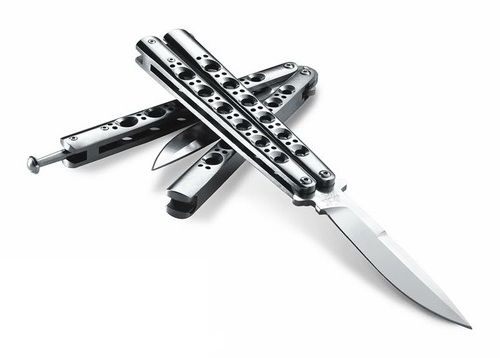The Balisong
This is the start of Balisong Week. Not only am I going to review (and give away) the extremely hard to find Spyderco Smallfly, I am going to kick things off with an overview of this most interesting of blades.

If you like design and you like knives you have to at least appreciate the elegance of the balisong (known in the US also as a butterfly knife). Few things are as simple and effective as a balisong. The lock up is as solid as you can get in a folding knife. The deployment is so fast that it drew the ire of lawmakers when the updated the USA Switchblade Act (15 USC 1241-1245) the first time they had a chance to review and amend it. This is a design geek's knife.

The history of balisongs is fascinating. The name is derived, not from Benchmade, as their trademark on "Bali-Song" would have you believe, but from the Tagalog phrase "folding horn". It is a beautiful example of a clever turn of phrase: "baling sungay" becomes "balisong" and once translated you know exactly what a baling sungay is. There is no exact inventor, but they were very widespread in the Tagalog region of the Phillipines. Like the Barlow, the design of balisongs is such that they can be made with substandard materials and still perform very, very well. Typically they had brass or pot tin handles, saving the better metal, usually leaf springs, for the blade. If the maker had a lot of the higher quality steel available, they also fashioned the stop pins and the pivots out of them to help with the flipping action and to reduce the impact of wear and practice. Generally they came with clip point or spear point blades and almost always had a hollow grind.
I was lucky enough to have a friend that studied Filipino fighting techniques centered around the balisong. He saw me playing with my Spyderco BaliYo (good toy, terrible, terrible pen) and told me it was time to take the training wheels off. He was wrong--a few minutes into practicing with a real knife my slashed knuckles proved I was more uncoordinated than he thought. But the time he spent with me showing me how to open and close the balisong was not only a good deal of fun, it was illuminating. He has used a balisong for so long and made so many of his own that he knows the design inside and out and his information has helped me appreciate what makes a good balisong good.
First, you want very loose pivots. Even those with a bit of blade play are fine, so long as it is forced out when the knife is fully deployed. Second, you want handles that don't quite meet on their own. They should only meet when you put pressure on them, and that means they should have a bit of flex to them. Third, the stop pins need to strike the handles in just the right place. If they don't the whole knife doesn't work. Finally and most importantly you want handles that are rounded over to allow for smooth, fluid flipping.
All of this pretty basic stuff, especially for people that have been using and flipping balisongs for a long time, but it was all new to me.
All of this pretty basic stuff, especially for people that have been using and flipping balisongs for a long time, but it was all new to me.
The takeaway, besides the centrality of flipping to the balisong design, is the fact that like the Barlow and the AK-47, this is a tool and a weapon that can be made to work very, very well with substandard materials and relatively low-tech manufacturing methods. The amount of blade play shocked me, but my friend insisted that was actual a GOOD thing. And he was dead on. The rounded over handles look cheap, as if they are cut from rods (which is probably true of authentic lower budget Filipino designs), but again that form factor actually works best. In the end I realized that the balisong is not just a triumph of good design (which it is), but it is also a triumph of great production. Everything is in service to performance, and you can achieve performance with very basic and rudimentary materials.
If its legal where you live and you haven't tried out a balisong, it is probably worth a try. You can find absolutely suitable designs for around $30. They will be more than enough to get you started. One pro-tip from Mr. Uncoordinated--tape off the cutting edge until you get the flipping down pat. Or at least that's what my knuckles told me to tell you.

